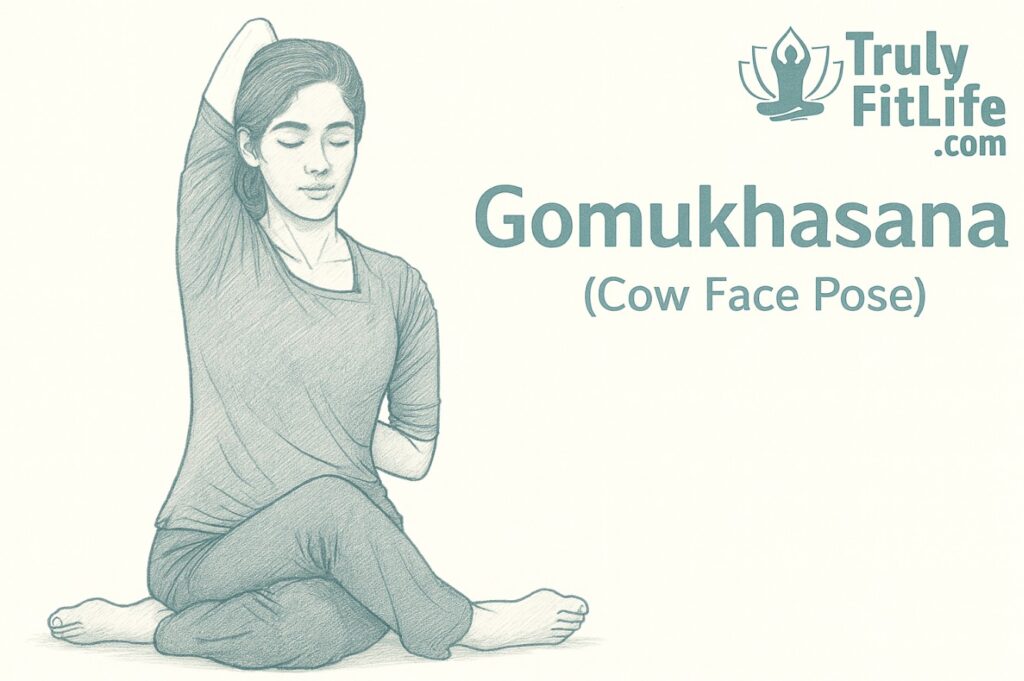
Gomukhasana (Cow Face Pose) is a classical seated yoga asana that combines a hip-opening leg position with a deep shoulder stretch. The name comes from Sanskrit: “Go” meaning cow, “Mukha” meaning face, and “Asana” meaning pose. When performed, the position of the legs resembles a cow’s mouth and the arms look like its ears.
This pose is considered both a seated posture and a therapeutic asana, particularly effective for opening the chest, stretching tight shoulders, and relieving tension in the hips. It is mentioned in traditional Hatha Yoga practices and widely taught in modern yoga classes.
Step-by-Step Instructions to Practice Gomukhasana – Cow Face Pose
1. Starting Position
- Sit on your yoga mat in Dandasana (Staff Pose) with legs extended forward.
- Ensure spine is upright and shoulders relaxed.
2. Leg Positioning
- Bend the left leg and place the left heel under the right hip.
- Cross the right leg over the left, stacking knees so the right knee rests directly above the left.
- Both feet should point backward and rest beside the hips.
3. Arm Placement
- Raise the right arm overhead, bend the elbow, and place the hand behind the upper back.
- Take the left arm behind the back and try to clasp fingers (use a strap if hands do not touch).
4. Alignment
- Keep the chest open, spine tall, and gaze forward.
- Breathe deeply, avoiding tension in the shoulders or face.
5. Duration
- Hold for 20–40 seconds initially, gradually extending up to 1–2 minutes.
- Repeat on the other side to maintain balance.
Alignment Tips
- Sit on a folded blanket if hips are tight.
- Use a yoga strap between hands if shoulders are stiff.
- Keep knees stacked as much as possible without forcing them.
Benefits of Gomukhasana – Cow Face Pose
🦴 Physical Benefits
- Opens Shoulders & Chest: Relieves stiffness from long hours of desk work.
- Improves Hip Flexibility: Stretches glutes, thighs, and inner hips.
- Strengthens Posture: Aligns the spine and prevents slouching.
- Enhances Circulation: Boosts blood flow in shoulders and pelvic region.
- Therapeutic Benefits: Helps reduce sciatica discomfort and back tightness.
🧘♂️ Mental & Emotional Benefits
- Reduces Stress: Releases physical tension stored in shoulders and hips.
- Boosts Concentration: Promotes stillness and focus in seated position.
- Encourages Emotional Release: Often said to unlock suppressed emotions held in hips.
- Grounding & Calming: Balances body energy and prepares for meditation.
Contraindications & Precautions
- ❌ Avoid if you have severe shoulder or knee injuries.
- ❌ People with recent hip surgery should not attempt.
- ⚠️ Use props if unable to clasp hands—never force shoulders.
- ⚠️ Beginners should start with gentler hip openers before attempting.
👉 Modification: Place a yoga block under hips or use a strap for arms.
Modifications & Variations
- Arms Only: Sit in Sukhasana (Easy Pose) and practice the arm bind.
- Legs Only: Cross legs in Gomukhasana shape without the arm bind.
- Supported Variation: Perform against a wall for better posture support.
Drishti (Gaze Point)
- Nasagra Drishti (Tip of Nose): Improves focus.
- Or gently close the eyes for meditative awareness.
Chakras Activated
- Anahata (Heart Chakra): Opens chest and heart space.
- Muladhara (Root Chakra): Provides grounding through seated base.
- Svadhisthana (Sacral Chakra): Activates pelvic region energy.
Practice Suggestions
- Practice after warm-up with shoulder and hip stretches.
- Ideal for people with desk jobs or sedentary lifestyles.
- Beginners may focus separately on arms and legs before combining.
- End with gentle counterposes such as Child’s Pose (Balasana) or Cat-Cow Stretch.